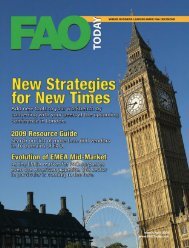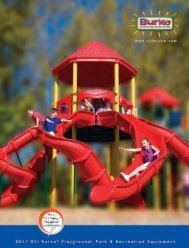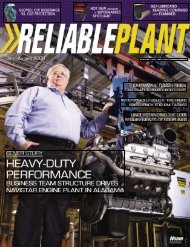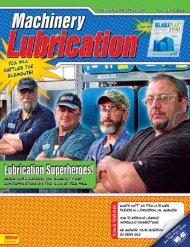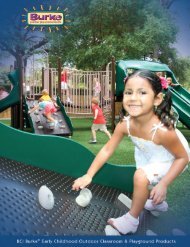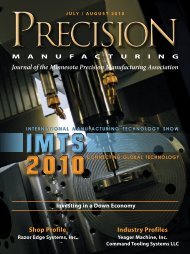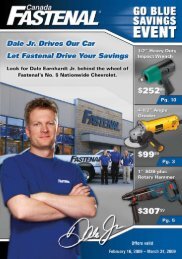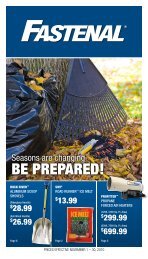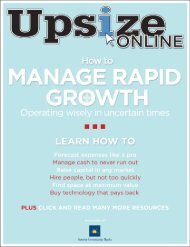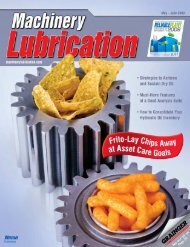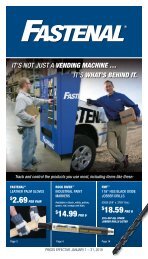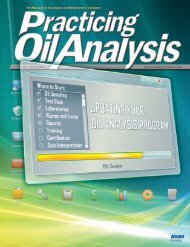Machinery Lubrication July August 2008
Machinery Lubrication July August 2008
Machinery Lubrication July August 2008
Create successful ePaper yourself
Turn your PDF publications into a flip-book with our unique Google optimized e-Paper software.
VIEWPOINT<br />
Check Yes or No<br />
Wherever possible, questions should be<br />
stated in a simple yes/no format. For example,<br />
“oil appears clean and clear?” with an appropriate<br />
check box for yes or no. Training should<br />
be provided so that operators can easily determine<br />
what cloudy or discolored oil looks like<br />
along with basic tools such as an infrared<br />
temperature gun to measure bearing temperature<br />
or a laser pointer to check for oil clarity.<br />
The inspection routes should be captured<br />
in a simple check sheet format, either electronically<br />
(preferred) or manually. They<br />
should be easily accessible at the machine, but<br />
should also require sign-off to avoid pencilwhipping.<br />
While a simple sign-off process<br />
doesn’t necessarily guarantee that the task<br />
was performed, human nature is such that we<br />
naturally feel more accountable when physically<br />
signing a document or form.<br />
While paper-based inspection routes do<br />
work, all too often, the extra time required to<br />
capture manual route sheets and input into a<br />
tracking spreadsheet or database means that<br />
good intentions often go astray as more<br />
pressing tasks arise. The most successful<br />
inspection routes involve electronic data<br />
collection in the field, using either a rugged,<br />
industrial personal digital assistant (PDA) or<br />
tablet personal computer (PC).<br />
Not only does this offer the advantage that<br />
the information gathered is already databased,<br />
but the PDA or PC can also be used to<br />
include simple drawings or pictures indicating<br />
where inspection points are located and what<br />
normal vs. abnormal conditions look like.<br />
Once databased, a process needs to be put<br />
in place to periodically review the data, and<br />
where necessary, create appropriate maintenance<br />
work orders to correct the problem.<br />
There is no easier way to kill an inspection<br />
program than to send the message that<br />
nobody is looking at the data. In every case<br />
where I’ve seen this happen, the operators<br />
simply stopped performing the inspections.<br />
None of us likes to feel like we’re wasting our<br />
time, and operators are no different.<br />
Multiple Disciplines<br />
Inspections should be cross-disciplinary.<br />
They should include lubrication, mechanical<br />
maintenance, electrical, safety and operational<br />
inspections. It makes little senses to<br />
conduct one survey for lubrication, followed<br />
by a similar survey for electrical systems on the<br />
same machine. If your plant has different<br />
maintenance planners for different maintenance<br />
functions (mechanical, electrical,<br />
production, etc.), inspections can easily be<br />
divided once the information has been gathered.<br />
The critical path is getting good data:<br />
the rest will fall in place accordingly.<br />
When it comes to lubrication, industry<br />
studies reveal that, on average, 30 to 60<br />
percent of all maintenance problems can be<br />
traced to lubrication. It is likely that 70 to 80<br />
percent of those could have been avoided<br />
simply by looking for the correct oil level or<br />
condition, evidence of a seal or breather<br />
failure, or the observation that an automatic<br />
greasing system is not functioning correctly.<br />
Human Resources<br />
Take advantage of the people who are in<br />
front of machines eight to 12 hours a day and<br />
involve operators as part of the solution,<br />
rather than blaming them as part of the<br />
problem.<br />
As always, this is my opinion. I’m interested<br />
in yours.<br />
About the Author<br />
As a skilled educator and consultant in the areas of<br />
oil analysis and machinery lubrication, Mark Barnes has<br />
helped numerous clients develop effective machinery<br />
lubrication programs and troubleshoot complex lubrication<br />
problems through precision lubrication and oil<br />
analysis. As vice president and chief technical officer of<br />
Noria Reliability Solutions, Mark and his group work on<br />
projects in the areas of: plant audits and gap analysis,<br />
machinery lubrication and oil analysis program design,<br />
lube PM rationalization and redesign, lubricant storage<br />
and handling, contamination control system design and<br />
lubrication, and mechanical failure investigations.<br />
Contact Mark at mbarnes@noria.com.<br />
8 <strong>July</strong> - <strong>August</strong> <strong>2008</strong> machinerylubrication.com <strong>Machinery</strong> <strong>Lubrication</strong>



